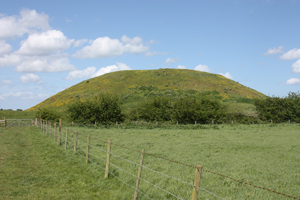Archaeologists uncover massive iron age mound - 2500 year old Yorkshire mound is first discovered in UK
Release Date 03 October 2016

University of Reading archaeologists say that Skipsea Castle in Yorkshire is actually more similar to Silbury Hill in Wiltshire than a Norman Conquest-era ‘motte and bailey’ castle, as previously thought.
The discovery of the ‘Silbury Hill of the North’ makes Skipsea Castle a unique Iron Age monument in Britain. Previously, only smaller burial mounds from this period were known about. The closest mound of a similar size is in Germany.
Dr Jim Leary, the University of Reading archaeologist who led the excavation, said: “To say that the discovery of an Iron Age monument hiding in plain sight was surprising is an understatement. Conventional wisdom has suggested that castle mottes were brought to England by the Normans, following the conquest that began in October 1066, exactly 950 years ago.
“Castle mottes exist up and down the country, but their huge size means they are rarely excavated and as a result much of what we previously thought we knew about their date was based on scant documentary evidence and guesswork.
“I excavated Silbury in Wiltshire in 2008, and now to discover the Silbury Hill of the North is wonderful. It adds so much more to our understanding of the people who lived in Britain 500 years before the Romans arrived.”
Novel technique
The discovery was made using a novel technique to investigate, for the first time, some of the best known mottes in England, to learn more about when they were built or re-used.
Working alongside colleagues at the Scottish Environmental Research Centre at East Kilbride, the team from Reading have shown that although the majority of the mounds investigated so far were built in the period immediately after the Norman Conquest in 1066, there are some remarkable exceptions.
Radiocarbon dating has shown that some mounds were built centuries later than expected. However, Skipsea Castle mound in Yorkshire was already 1,500 years old at the time of the Norman Conquest.
The new results show that this huge mound – which is 85m in diameter and stands 13m high – dates to the middle of the Iron Age and therefore unique in Britain at the time, with only a handful of parallels on the Continent.
Dr Jim Leary added: “We are able, for the first time, to reveal the date of construction, sequence of development and environmental context of these wonderful monuments, providing insights never previously thought possible.
“Our work continues for another year and we will continue to add to our knowledge of castle mounds. With luck, we might even find more prehistoric mounds in Britain, hiding from us in plain sight.”
Apple Corer
To recover dateable material locked within these monuments, the archaeologists drilled small boreholes through the tops of each mound down to their bases.
Dr Leary said: “These boreholes act like a giant apple corer providing us with a complete sequence through the fabric of the mounds with minimal disruption.
“From this we are able to recover material for laboratory analysis, whilst at the same time preserving the integrity of the monuments for generations to come.”
From tiny pieces of evidence, such as charred seeds or pollen, the archaeologists have been able to reconstruct the environment the mounds were built in, while organic material has been radiocarbon dated revealing the age of the mottes.
Additional information
Mottes are earthen mounds that often had a wooden or stone tower constructed on them, and were sometimes coupled with a defensive enclosure known as a bailey. The motte and bailey type castle was developed in northern Europe in the tenth century, and the design is thought to have been brought to England by the Normans following the Conquest in 1066.
October 2016 marks the 950th anniversary of the Norman Conquest. The Battle of Hastings was fought on the 14th October 1066 when Harold Godwinson fought and lost to Duke William of Normandy. William the Conqueror was proclaimed king of England on Christmas Day of 1066, marking the start of the Norman period of English history.
Dr Leary is the director of the Field School at the University of Reading and has previously worked on Silbury Hill, the Vale of Pewsey and Marden Henge (c.2500BC), the largest neolithic henge in Britain.
The project, entitled “Extending Histories: from medieval mottes to prehistoric round mounds”, is being funded by the Leverhulme Trust, and runs for another year. Details of the project and updates can be found at:https://roundmoundsproject.wordpress.com/
The Leverhulme Trust was established by the Will of William Hesketh Lever, the founder of Lever Brothers. Since 1925 the Trust has provided grants and scholarships for research and education; today it is one of the largest all-subject providers of research funding in the UK, distributing approximately £80 million a year. For more information: www.leverhulme.ac.uk
